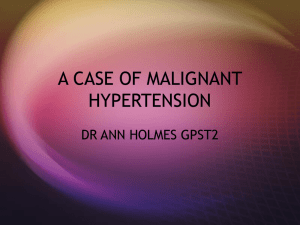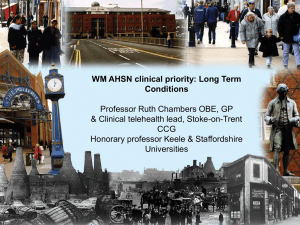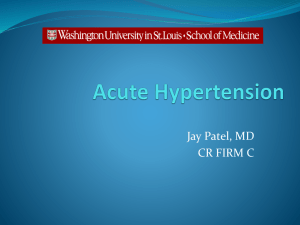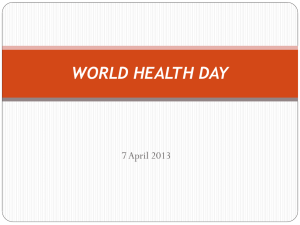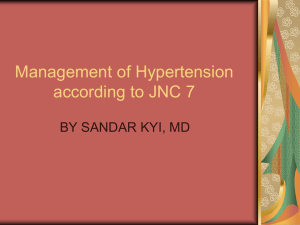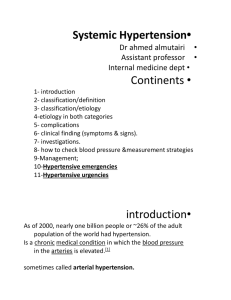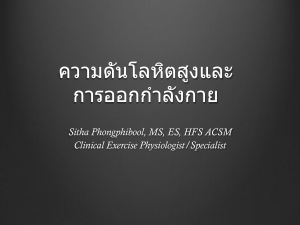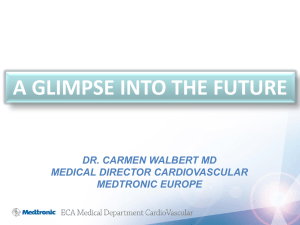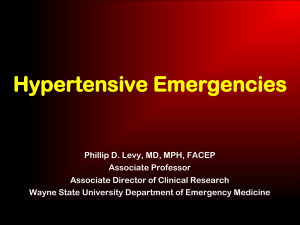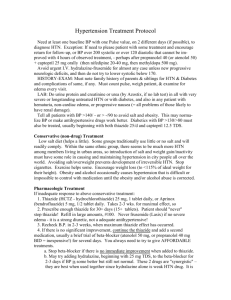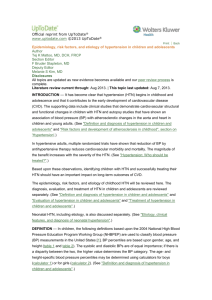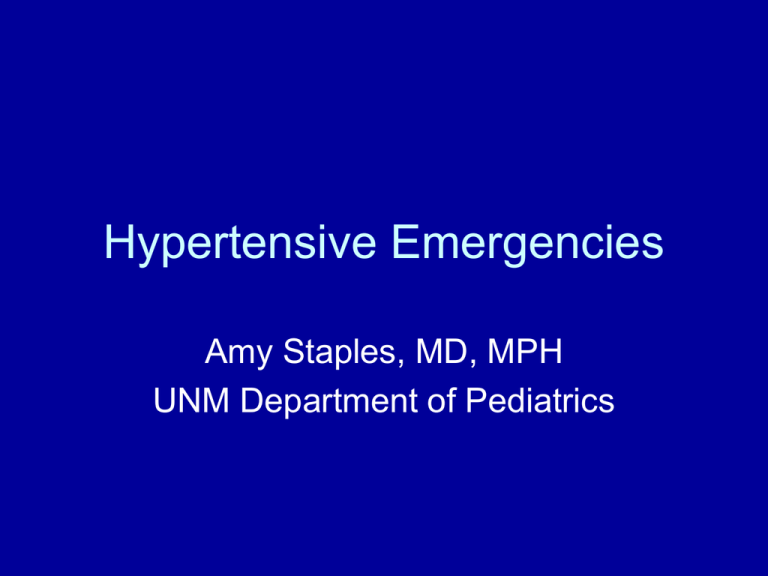
Hypertensive Emergencies
Amy Staples, MD, MPH
UNM Department of Pediatrics
Outline
•
•
•
•
•
Measuring BP
Definition of Hypertension
Etiology of hypertension in kids
When to treat
How to treat
Clinical Quiz
1. 11 yo girl with a
sinusitis, HA and BP
124/83
2. 5 yo boy with rash,
abd pain, joint pain,
tea colored urine
and BP 117/81
3. 16 yo athletic boy in
clinic for sports PE
BP 132/84
HTN
___
Treat
___
___
___
___
___
Clinical Quiz
4. 3 yo girl with NF, alert
and playful; BP 125/77
5. 2 yo girl with nephrotic
syndrome admitted for
albumin/lasix due to
anarsca, with severe HA
and seizure, BP 119/76;
on admit 93/52
HTN
Treat
___
___
___
___
Outline
•
•
•
•
•
Measuring BP
Definition of Hypertension
Etiology of hypertension in kids
When to treat
How to treat
Measuring accurate BP’s
• Cuff too small → high reading
• Cuff too big → OK reading or no reading
(usually not falsely low)
• Lower extremities - Normally, BP is 10 to
20 mmHg higher in the legs than the arms
– Prefer arm if at all possible
– Right arm for comparison with standards
Cuff Size
• Bladder width > 40% of
mid-arm circumference.
• Bladder length 80-100%
of arm circumference.
A. Ideal arm circumference
B. Range of acceptable arm
circumferences
C. Bladder length
D. Midline of bladder
E. Bladder width
F. Cuff width
Oscillometric Devices
Measure mean arterial pressure (MAP) and
calculates SBP and DBP
– The algorithms used are proprietary and NOT
standardized
– Results can vary widely and they do not
always closely match BP values obtained by
auscultation
– These machines must be calibrated regularly
Manual vs. Automatic
• Manual is the gold standard
• Oscillometric measurements preferred in
infants and ICU settings ONLY
• All high readings should be confirmed with
a manual
Confirming High BP’s
• Repeat BP in both arms and one leg (both
not usually necessary)
• Repeat 3 times to assure accurate
• Dx of HTN requires elevated BP’s on 3
separate occasions
Disappearance of “HTN” with
Repeated Measurement
100%
17%
80%
52%
60%
40%
80%
83%
Normal
48%
20%
20%
0%
1st Screen
(N=2460)
HTN
2d Screen
(N=323)
3d Screen
(N=87)
Outline
•
•
•
•
•
Measuring BP
Definition of Hypertension
Etiology of hypertension in kids
When to treat
How to treat
New BP Normals
• 4th report on the diagnosis, evaluation and
treatment of high blood pressure in
children and adolescents
– Correlates with the JNC 7
– Uses new growth parameter data from
NHANES
Definitions
Normotensive
• Average SBP and DBP <90th % for age, sex and
height
Pre-hypertension
• Average SBP or DBP >90th but <95th percentile
(OR >120/80)
Hypertension
• Average SBP and/or DBP >95th percentile for
age, sex and height on 3 separate occasions
– Stage 1: 95th-99th percentile + 5 mmHg
– Stage 2: >99th percentile + 5 mm Hg
How to use the tables
• Need:
– Age, gender, height percentage
– BP charts
7 yo boy
Ht 75%tile
50% 99/58
90% 113/73
95% 119/80
99% 127/88
http://www.cc.nih.gov/ccc/pedweb/pedsstaff/bptable1.PDF
BP tables for Infants
*Task Force on Blood Pressure Control in Children. Report of the Second Task Force on Blood Pressure Control in Children—
1987.Pediatrics.1987;79:1–25(PR)
Urgency vs. Emergency
• Urgency – severely elevated BP with no
current evidence of secondary organ
damage, although if left untreated, target
organ injury may result imminently
→ Decrease BP Soon
• Emergency – severely elevated BP with
evidence of target organ injury
→ Decrease BP Immediately
• Target organs – CNS, heart, kidney, eye
Constantine and Linakis, Pediatric Emergency Care, 2005
Severe Hypertension
“Hypertension that represents a threat to
life or to the function of vital organs”
OR
Severe hypertension is when your blood
pressure goes up too!
Adelman, et al. Pediatric Nephrology, 2000
Outline
•
•
•
•
•
Measuring BP
Definition of Hypertension
Etiology of hypertension in kids
When to treat
How to treat
Etiology of Hypertension
Newborn
•Renal vein
thrombosis
•Coarctation
•Renal artery
stenosis
•Congenital renal
anomalies
Early Childhood
(Infant-6 yo)
•Renal
parenchymal
disease
•Renovascular
disease
•Coarctation
School Age
(6-12 yo)
•Renal
parenchymal
disease
•Renovascular
disease
•Essential
hypertension
Constantine and Linakis, Pediatric Emergency Care, 2005
Adolescence
•Essential
hypertension
•Renal
parenchymal
disease
•Renovascular
disease
Miscellaneous Causes
• Endocrine
– Hyperthyroid
– Pheochromocytoma
•
•
•
•
•
•
Elevated ICP/CNS disease
Drug use (cocaine, ecstasy)
Medication (abrupt withdrawal)
Exercise
Traction
Hypovolemia
Overall
• 15-20% Essential Hypertension
• 80-85% Secondary Hypertension
– 60-80% Renal
– 8-10% Renovascular
– 2% Coarctation
Outline
•
•
•
•
•
Measuring BP
Definition of Hypertension
Etiology of hypertension in kids
When to treat
How to treat
Which hypertensive patients need
immediate treatment?
1. Severe HTN
•
•
Malignant HTN - >30% above 95%
Moderate – Severe HTN - >99% with target
organ damage
2. Symptomatic HTN
3. Target Organ Damage
Complications of Severe HTN
Retinopathy
Encephalopathy
LVH
Facial palsy
Visual changes
Hemiplegia
Deal, et al. Arch Dis Child, 1992
27%
25%
13%
12%
9%
8%
Clinical Signs of Malignant HTN
• Eyes
– Retinal hemorrhages, exudates and papilledema
• Malignant Nephrosclerosis
– ARF, Hematuria, Proteinuria
• Hypertensive Encephalopathy
– Headache, nausea, vomiting
– Restlessness, confusion seizures, coma
– MRI (T2-weighted images) ;
• Edema of the white matter of the parieto-occipital regions: posterior
leukoencephalopathy
Eyes
Papilledema, blurred optic disk, hemorrhages
Hypertensive Encephalopathy
• Failure of autoregulation
Shifted
baseline
Flynn, Ped Neph 2009; 24, 1101-1112
Hypertensive Encephalopathy
• Headache, nausea, vomiting
• Restlessness, confusion → seizures,
coma
• Posterior Leukoencephalopathy
Posterior Leukoencephalopathy
T1 weighted
images – normal
appearing
T2 weighted
images – occipital
hyperintensity
Outline
•
•
•
•
•
Measuring BP
Definition of Hypertension
Etiology of hypertension in kids
When to treat
How to treat
Severe Hypertension
• Treatment Goals
– Prevent adverse events
– Reduce BP in controlled manner
– Preserve target organ function
– Minimize complications of therapy
Severe Hypertension
• Treatment Risks
– Rapid reduction of BP can lead to
complications
• Risk of hypoperfusion (ischemia) secondary to
autoregulation
• Medication side effects may have adverse effects
depending on cause of hypertension (e.g. ACEi)
How Much
Just Enough
Depends on Acute vs. Chronic
How Much
• Reduce by 25% of the planned reduction
over 8-12 hrs
• Another 25% over the next 8-12 hrs
• Final 50% over the next 24 hrs
• Planned reduction – goal is to the 95-99%
for age and height
If Unsure, slower is safer
What to do 1st
• Monitor, Monitor, Monitor
• Need cardiopulmonary monitoring
• Need continual BP monitoring (frequently
cycling cuff vs. arterial line)
• Decide oral vs. IV
– Oral OK if asymptomatic
– IV necessary if acute target organ damage is
present or imminent
Oral vs. IV
IV Medication
• Rapid Action
• Titratable
• Easy to adjust the
dose
• Requires IV access
PO Medication
• Don’t need an IV
• Harder to control
effects
• Absorption variable
• Slower kinetics can
make titrating more
difficult
What to choose
First Line
• PO
– Isradipine
– Nifedipine
• IV
– Nicardipine
– Nitroprusside
– Labetalol
Second Line
• PO
– Clonidine
• IV
– Hydralazine
– Enalaprilat
– Fenoldopam
Isradipine
• Ca channel blocker (Inhibit Ca++ entry into
smooth muscle cells → vasodilitation)
• Onset of action 30-60 minutes
• Side Effects: peripherial edema, flushing,
nausea, headache, tachycardia
• 0.05-0.1 mg/kg/dose q 4-6 hrs
• 2.5 mg and 5 mg tab, 1mg/1ml suspension
Nifedipine – 0.1-0.25 mg/kg q 4-6 hours (10 mg tab available)
Onset of action 15-30 min
A note on Short acting Ca Channel Blockers
• In adults with severe elevations in BP, Nifedipine
has been associated with*:
– Cerebral ischemia
– Myocardial ischemia
– Symptomatic hypotension
Preexisting MI, CAD, and hypovolemia predispose to these
events.
• In children Nifedipine / Isradapine have not been
associated with cerebral or myocardial events. †
*Grossman E, JAMA 1996;276:1328-31
†Sinaiko AR, NEJM 1997;336:1675
Nicardipine
• Ca channel blocker
• Onset of action within minutes
• Side Effects: same as isradipine
• 1-3 mcg/kg/min continuous infusion
Nitroprusside
• Direct arteriolar/venous dilator (via nitric
oxide donation)
• Onset of action within seconds
• Side Effects: cyanide/thiocyanate toxicity
• 0.5-1 mcg/kg/ min initially, titrate to max
10 mcg/kg/min
• Must monitor cyanide levels if used for >24
hrs
Labetalol
• Mixed alpha/beta blocker
• Onset of action 5-10 min
• Side Effects: bronchospasm,
contraindicated in asthma, cardiogenic
shock, pulmonary edema, or heart block
• 0.2-0.3 mg/kg/dose q 10-20 min (max
dose 20mg) can be converted into a drip
Enalaprilat
• ACE inhibitor (prevents the vasoconstrictive and Na retaining effects of the
RAS)
• Onset of action 15 min, long duration of
action
• Side Effects: risk of decreased GFR
• 0.005-0.01 mg/kg/dose
• Use in cases of severe renin mediated
HTN
Hydralazine
• Direct arteriolar vasodilator
• Side Effects: may cause Lupus-like
syndrome
• Can be given PO, IV, IM
• 0.1 - 0.5 mg/kg q 4-6 hr (max 20 mg/dose)
Case # 1
11 yo girl with a sinusitis, HA and BP 124/83
Ht 75th%
Blood Pressures
50% -105/62
95% -122/80
99% -128/87
Diagnosis
Pain, repeat when well, no treatment
Case # 2
5 yo boy with rash, abd pain, joint pain, tea
colored urine and BP 117/81
Ht 25th%
Blood Pressures
50% - 93/52
95% - 110/71
99% - 118/79
Diagnosis
GN, treat with medication, likely Ca channel
blocker
Case # 3
16 yo athletic boy in clinic for sports PE
BP 132/84
Ht 90th%
Blood Pressures
50% - 119/67
95% - 137/86
99% - 144/94
Diagnosis
Possibly Pre HTN, need repeat measurements
and TLC
Case # 4
3 yo girl with NF, alert and playful
BP 125/77
Ht 25%
Blood Pressures
50% - 88/48
95% - 105/66
99% - 113/74
Diagnosis
NF (possible associated renal artery stenosis),
Stage 2 HTN, treat with medication, renal
vascular imaging
Case # 5
2 yo girl with nephrotic syndrome admitted for
albumin/lasix due to anarsca, with severe HA
and seizure BP 119/76; on admit 93/52
Ht – 75th%
Blood Pressures
50% - 89/46
95% - 107/64
99% - 114/71
Diagnosis
Acute HTN with end organ involvement, stop
albumin, give lasix, consider IV therapy if sz
continues
Flynn, Ped Neph 2009; 24, 1101-1112

